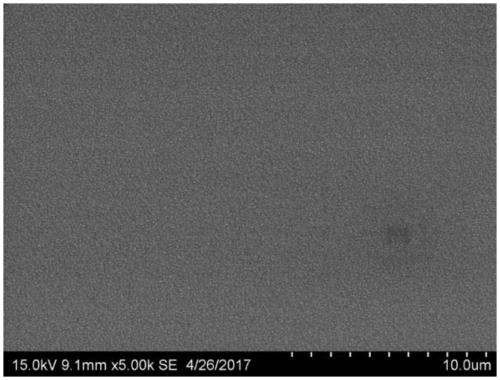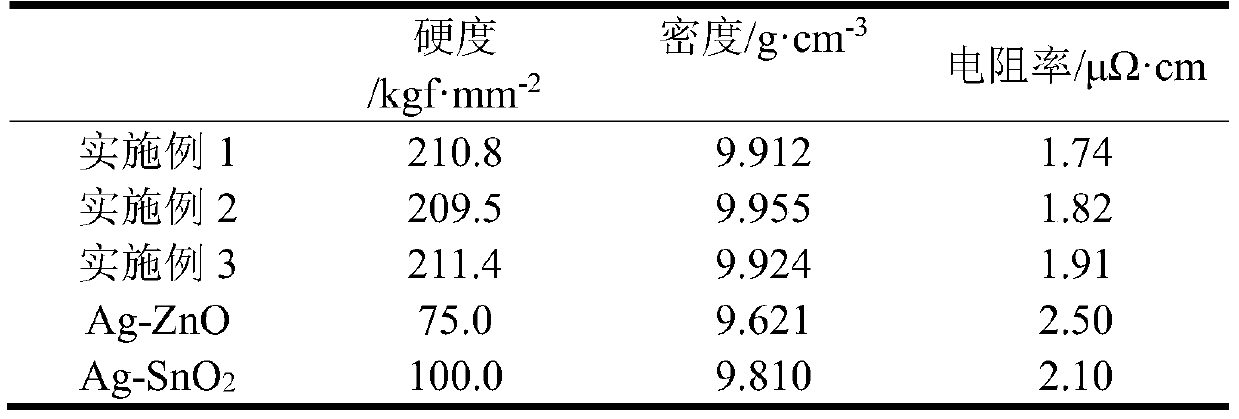A kind of ag-max phase nanocomposite coating and deposition method thereof
A nano-composite and coating technology, applied in the field of surface engineering, can solve problems that have not been recorded in any way, and achieve the effects of good uniformity, fine grains, and good arc ablation resistance
- Summary
- Abstract
- Description
- Claims
- Application Information
AI Technical Summary
Problems solved by technology
Method used
Image
Examples
Embodiment 1
[0041] First, the copper substrate is mechanically polished, then soaked in acetone and absolute ethanol for ultrasonic cleaning, and then placed in double-distilled water for ultrasonic cleaning to further clean the contact and target surface, and then air-dried with hot air.
[0042] Set the installation distance between the target and the substrate to 5cm, close all the inlet pipes and outlet pipes after installation, and vacuumize the entire cavity so that the vacuum degree in the entire cavity reaches 1.0×10 -5 Pa. Turn on the substrate heater and heat the temperature of the copper substrate to 500°C. At the same time, pay attention to the change of the pressure in the cavity and continue to evacuate outward to prevent the pressure inside the cavity from rising. After heating the temperature of the copper substrate to 500°C, open the inlet pipe to let in argon gas, control the pressure in the chamber to reach the specified deposition pressure value, and then stop the gas ...
Embodiment 2
[0044] First, the copper substrate is mechanically polished, then soaked in acetone and absolute ethanol for ultrasonic cleaning, and then placed in twice-distilled water for ultrasonic cleaning to further clean the contact and target surface, and then air-dried with hot air.
[0045] Set the installation distance between the target and the substrate to 7cm, close all the inlet pipes and outlet pipes after installation, and vacuumize the entire cavity so that the vacuum degree in the entire cavity reaches 1.0×10 -5 Pa. Turn on the substrate heater and heat the copper substrate to 500°C. At the same time, pay attention to the change of the pressure in the cavity and continue to evacuate outward to prevent the pressure inside the cavity from rising. After heating the temperature of the copper substrate to 500°C, open the inlet pipe to let in argon gas, control the pressure in the chamber to reach the specified deposition pressure value, and then stop the gas flow. A KrF excimer...
Embodiment 3
[0047] First, the copper substrate is mechanically polished, then soaked in acetone and absolute ethanol for ultrasonic cleaning, and then placed in twice-distilled water for ultrasonic cleaning to further clean the contact and target surface, and then air-dried with hot air.
[0048] Set the installation distance between the target and the substrate to 8cm, close all the air intake pipes and air outlet pipes after installation, and vacuumize the entire cavity so that the vacuum degree in the entire cavity reaches 1.0×10 -5 Pa. Turn on the substrate heater and heat the copper substrate to 500°C. At the same time, pay attention to the change of the pressure in the cavity and continue to evacuate outward to prevent the pressure inside the cavity from rising. After heating the temperature of the copper substrate to 500°C, open the inlet pipe to let in argon gas, control the pressure in the chamber to reach the specified deposition pressure value, and then stop the gas flow. A Kr...
PUM
| Property | Measurement | Unit |
|---|---|---|
| thickness | aaaaa | aaaaa |
| wavelength | aaaaa | aaaaa |
| thickness | aaaaa | aaaaa |
Abstract
Description
Claims
Application Information
 Login to View More
Login to View More - R&D
- Intellectual Property
- Life Sciences
- Materials
- Tech Scout
- Unparalleled Data Quality
- Higher Quality Content
- 60% Fewer Hallucinations
Browse by: Latest US Patents, China's latest patents, Technical Efficacy Thesaurus, Application Domain, Technology Topic, Popular Technical Reports.
© 2025 PatSnap. All rights reserved.Legal|Privacy policy|Modern Slavery Act Transparency Statement|Sitemap|About US| Contact US: help@patsnap.com


